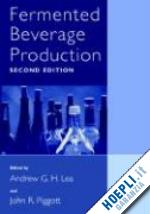1 Production of Fermentable Extracts from Cereals and Fruits.- Structure of Cereals.- Grain Development.- The Cereal Endosperm.- Cereal Storage Polymers.- Starch.- Amylose.- Amylopectins.- Starch Granules.- Starch Lipids.- Storage Proteins.- Cereal Lipids.- Cereal Cell Walls.- Basic Structure.- Glucans and Celluloses.- Hemicelluloses.- MALTING.- Outline of Barley Malting.- Changes in Barley Cell-Wall Components During Malting.- Changes in Endosperm Proteins.- Changes in Starch.- Depolymerization Activities During Mashing.- The Biochemistry of Mashing.- Depolymerization of Starch Polymers.- Cell-Wall Degradation.- Protein and Nucleic Acid Solubilization and Breakdown.- Lipid Extraction During Mashing.- Continued Activities During Distillery Fermentation.- Degradation of Branched Dextrins.- Formation of Ethyl Carbamate.- Multiple Parallel Fermentation.- Fruits as Raw Materials.- Fruit Juices and Their Composition.- Fruit Pulping.- Implications of Processing Certain Fruits.- REFERENCES.- 2 Alcoholic Beverage Fermentations.- YEAST.- PHYSIOLOGY OF YEAST GROWTH.- Nutritional Requirements.- Carbohydrate Utilization.- Uptake of Glucose.- Glucose and the Uptake of Maltose.- Glucose and the Uptake of Sucrose.- Utilization of Nitrogen Sources.- Ethanol Fermentation.- PRODUCTION OF FLAVOR COMPOUNDS.- Higher Alcohols.- Organic Acids.- Esters.- Carbonyl Compounds.- Malo-lactic Fermentation.- Sulphur Compounds.- REFERENCES.- 3 Beers: Recent Technological Innovations in Brewing.- THE TRADITIONAL BREWING PROCESS.- Raw Materials.- Wort Production.- Wort Fermentation and Maturation.- NEW TECHNOLOGICAL EVOLUTIONS.- Raw Materials.- Wort Production.- Fermentation and Maturation.- NEW PRODUCTS: LOW ALCOHOL BEER, ALCOHOL-FREE BEER, AND ICE BEER.- Low-Alcohol Beer and Alcohol-Free Beer.- Physical Removal of Ethanol.- Adaptation of the Traditional Process.- Ice Beer.- CONCLUSION.- REFERENCES.- 4 Cidermaking.- HISTORY AND DEFINITION.- RAW MATERIALS.- Cider Apples.- Milling and Pressing.- Juice Additions.- FERMENTATION.- Yeast Selection.- Malo-lactic Fermentation.- Sulfite Binding.- Cider Color.- Cider Flavor.- POST-FERMENTATION OPERATIONS.- Racking and Storage.- Storage Disorders.- Flavor Disorders.- CONCLUSION.- REFERENCES.- 5 White Wines.- WINE STYLES AND GRAPE VARIETIES.- Dry, White, Floral and Fruity Wines.- Medium-Dry, White, Floral and Fruity Wines.- Dry, White, Full-Bodied Wines.- Sweet, White Table Wines.- IMPROVED PLANTING MATERIAL.- THE VINEYARD AND HARVEST.- The Vineyard.- Harvest.- PREFERMENTATION TREATMENTS.- YEAST AND FERMENTATION CONTROL.- POSTFERMENTATION OPERATIONS.- REFERENCES.- 6 Red Wines.- STYLES OF RED TABLE WINES.- GRAPE MATURITY AND HARVESTING.- PREFERMENTATION OPTIONS.- JUICE, SKIN AND SEED CONTACTING.- Maceration Prior to Fermentation.- Conventional Maceration.- Maceration After the Fermentation.- Carbonic Maceration.- Color and Component Extraction During Conventional Maceration.- The Role of Copigmentation.- The Rates of Component Extraction.- Extraction From Seeds.- The Use of Temperature and Contacting Time To Enhance Extraction.- The Choice of Time to Press.- THE ETHANOL FERMENTATION.- Must Preparation.- Yeast Inoculation.- Fermentation Temperature.- Concurrent Malo-Lactic Fermentation.- Prediction of Fermentation Behavior.- Fermentation Problems.- Heat Evolution.- Gas Evolution.- MALO-LACTIC FERMENTATION.- Malo-Lactic Bacteria.- Bacterial Nutrition.- Immobilized Bacteria.- POST-FERMENTATION HANDLING OF WINES.- AGING.- Aging Reactions.- Cooperage Considerations.- Microbial Control During Aging.- Evaporative Losses.- PREPARATION FOR BOTTLING.- REFERENCES.- 7 Sparkling Wines.- BASE WINES.- CARBONATION.- Levels and Terms.- Quantification of Carbonation.- Methods of Carbonation.- SECONDARY FERMENTATION BY YEAST.- Selection of Yeast and Conditioning.- Fermentation Temperature.- Culturing Techniques.- Inoculum Size.- Agglomerating Ability.- Enclosed or Encapsulated Yeast.- The Sugar Source for the Carbonating Fermentation.- The Vessel Used for the Carbonating Fermentation.- YEAST LEES AGING.- Overview of Lees Aging Reactions.- Non-Enzymic Effects on Composition of the Wine with Lees Contact.- Excretion of Amino Acids.- Autolysis and Enzymatic Activity.- METHOD OF CLARIFICATION.- No Clarification.- Riddling and Disgorging.- Filtration.- THE FINAL PACKAGE.- SWEETENING.- AGING OF SPARKLING WINES IN THE ABSENCE OF YEAST-EFFECT OF HEAT AND LIGHT.- General Sensory Effects of Heat.- Heat and the Formation of Ethyl Carbamate.- Heat and Maillard Reaction Products.- Heat and Changes in Ester Composition.- Heat and Oxidation.- Heat, Internal Pressure, and Bottle Seal.- Heat and Protein Instabilities.- Light.- FOAM AND BUBBLES.- Bubbles.- Foam.- CONCLUSION.- REFERENCES.- 8 Fortified Wines: Sherry, Port and Madeira.- Definition and Scope.- Origins and Current Status of Fortified Wines.- Outline of the Basic Processes.- ALCOHOLIC FERMENTATION.- FORTIFICATION SPIRIT.- SHERRY.- Definition.- Viticulture.- Climate and Soil.- Vineyards and Grape Varieties.- Vintage.- Vinification.- Pressing.- Fermentation and Fortification.- Styles of Wine.- Aging and Maturation.- Cellars.- The Solera System.- Aging Under Flor.- Maturation without Flor.- Sweetening and Color Wines.- Commercial Styles of Sherry.- Final Processing.- PORT.- Regulation.- Geographical Origin.- Viticulture.- Vintage.- Vinification.- Basic Styles of Wine.- Aging and Maturation.- Blending.- Commercial Styles of Port.- Wood Aged Styles.- Bottle Aged Styles.- Processing.- MADEIRA.- Regulation and Geographical Origin.- Viticulture.- Vintage.- Vinifìcation.- Aging and Maturation.- Blending.- Commercial Styles of Madeira.- Processing.- QUALITY ASPECTS.- Ethyl Carbamate.- Microbial Spoilage.- ACKNOWLEDGEMENT.- REFERENCES.- 9 From Vine to Cognac.- THE GEOLOGY AND THE ’CRU’ (GROWTH AREA).- THE VINE VARIETIES.- THE WINEMAKING.- Treatment of the Grapes in the First 5 Minutes.- From the Harvest to the Fermentation Vat.- The Fermentation.- THE CHARENTE DISTILLATION.- THE AGING OF COGNAC.- BLENDING: AN IMPORTANT STEP IN THE PROCESS OF COGNAC PRODUCTION.- The Development of the Chemical Equilibrium During Blending and Reduction.- Production of the Blend.- Notions of Age.- Commercial Denominations.- CONCLUSION.- REFERENCES.- 10 Armagnac and Wine-Spirits.- ARMAGNAC.- Historical Background.- Appellation Areas, Soils, Climate, Vine Stocks.- Vinifìcation.- Distillation and Regulations.- The Continuous Armagnac Still (Figure 10-2).- Two-Stage Pot Stills.- Analysis.- Traditional Analyses.- Gas Chromatography.- High-Pressure Liquid Chromatography (HPLC).- Sensory Analyses.- Analysis of Principal Ions in Armagnac Spirits.- Carbonyl Compounds in Wine Spirits.- Aging and Merchandizing Preparation.- WINE-SPIRITS.- Regulations.- Wine-spirits.- Brandy.- Distillation.- Wine Rectifiers (Manlier, 1925).- Indirect Rectifiers.- Batch Rectification for the Production of Wine-Spirits or Distillates (Figure 10-16).- Composition of Brandies.- Aging and Merchandising Preparation.- ETHYL CARBAMATE IN WINE SPIRITS.- Role of the Distillation Process.- Role of the Vine Cultivar.- Search for a Precursor in the Case of 22 A Baco Wine.- Catalytic Role of Copper.- Role of Light.- Hydrocyanic Acid.- Use of Ion Exchange Resins to Reduce EC Content.- CONCLUSION.- ACKNOWLEDGEMENTS.- REFERENCES.- 11 Whiskies.- MATERIALS.- MILLING, COOKING, AND MASHING.- Malt Whisky.- Grain Whisky.- FERMENTATION.- DISTILLATION.- Batch Distillation.- Continuous Distillation.- By-Products.- MATURATION.- Current Practice.- Cask Type.- Warehousing.- Sensory Changes During Maturation.- Chemical Changes During Maturation.- Extraction of Wood Components.- Reactions Involving Distillate Components.- Solution Changes That Affect the Release of Aroma-Compounds.- BLENDING.- FILTRATION.- RAW MATERIAL AND PRODUCT ANALYSES.- Sensory Assessment.- Raw Materials.- Cereals.- Yeast.- Water.- Mashing and Fermentation.- Distillation.- Maturation.- REFERENCES.- 12 Rum.- THE HISTORY OF RUM.- THE ORIG











